
Vol. 6, No.4, April 2010 |
 Printer-Friendly PDF Version Printer-Friendly PDF Version |
FDACS/WIFSS Course Schedule
The Florida Department of Agriculture and Consumer Services, Office of Agricultural Emergency Preparedness is again partnering with the Western (WIFSS) to bring Department of Homeland Security (DHS) Certified Agroterrorism Courses to Florida.

All courses are free and lunch is provided, thanks to a DHS grant through WIFSS. Additional sponsoring partners include UF’s Institute for Food and Agricultural Sciences (IFAS-Extension), the Florida Department of Health and the Regional Domestic Security Task Forces.
AWR-153 Principles of Detection and Diagnosis: Strategies and Technologies
- - Tuesday, May 18 – Ft. Myers: 8:00 a.m. to 4:00 p.m. Ft. Myers Regional Operations Center, 4700 Terminal Dr., Suite 6, Ft. Myers, FL 33901
- - Wednesday, May 19 – Bradenton: 8:00 a.m. to 4:00 p.m. Public Safety Center, 2101 47th Ter. East, Bradenton, FL 34203
- - Wednesday, June 23 – Pensacola: 8:30 a.m. to 4:00 p.m. Escambia County Public Safety, 6575 North “W” St., Pensacola, FL 32505
AWR-154 Principles of National Incident Management System (NIMS), Team Building, and Risk Communication
- - Thursday, May 20 – Seffner: 8:00 a.m. to 4:00 p.m. Hillsborough County Extension Office, 5339 South CR-579, Seffner, FL 33584
- - Thursday, June 24 – Tallahassee: 8:00 a.m. to 4:00 p.m. Betty Easley Conference Center, Room 152, 4075 Esplanade Way, Tallahassee, FL 32399
- - Tuesday, July 20 – Orlando: 8:00 a.m. to 4:00 p.m. Orange County Sheriff's Office Central Operations Center Mel Martinez Auditorium, 2500 W. Colonial, Orlando, FL 32804
- - Wednesday, July 21 – Gainesville: 8:00 a.m. to 4:00 p.m. USDA FSA, 4401 NW 25th Pl., Gainesville, FL 32606
- - Thursday, September 16 – Jacksonville: 8:00 a.m. to 4:00 p.m. Jacksonville Regional Operations Center, 921 N Davis St., Bldg. E, Jacksonville, FL 33209
Registration: http://wifss.ucdavis.edu/agroterrorism/classes/classesbydate.php
Information: http://wifss.ucdavis.edu/agroterrorism/classes/course_desc.php
For questions contact John Terry (850) 410-6756/251-4184 terryj1@doacs.state.fl.us
[top]
Large Animal Rescue Training
The UF College of Veterinary Medicine’s Large Animal Technical Rescue Team (a component of its disaster response team “VETS”), DVM students from the Public Health and Service Club (PHSC) and a Florida Veterinary Reserve Corps veterinarian, trained with 35 firefighters from St. Johns County and Clay County Technical Rescue Teams over the April 2-4 weekend at the Star 4 Ranch.
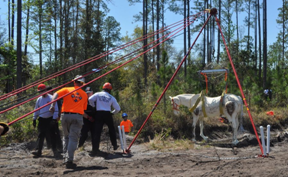
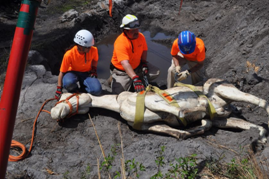
TOP LEFT: University of Florida VETS Team member David John (foreground in orange) and Vet Corps member Dr. Bill Shelton (background in orange) work with the Clay County Fire Technical Rescue Team to raise horse from a pit with an A-frame lift. (John Haven photo)
TOP RIGHT: Attaching webbing to a large, heavy animal such as a downed horse requires patience and use of special techniques. In photo l-r: 2nd year DVM Student Sareena Enloe, VETS Team Leader John Haven and Vet Corps member Dr. Bill Shelton. (Lana Haven photo)
The firefighters and PHSC students learned about safety around a horse during a rescue, techniques for safety moving a horse on the ground with webbing, “packaging” a horse for transport, and safe use of lifting systems on large animals.
These basic techniques were applied to scenarios involving rescuing the “packaged” horse up a steep embankment where a crane or helicopter is not available, using the A Frame (a portable crane system) to lift a downed horse from a hole, and righting an overturned horse trailer. The VETS team, with the help of the PHSC, the Leg-Up Fund and the American Association of Equine Practitioners, recently purchased the “Equine Rescue Randy” horse mannequin, which allows the team to train in realistic scenarios without risking injury to a live animal.

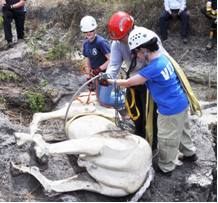
TOP LEFT: After carefully packaging the animal “victim,” the St. Johns County Fire Technical Rescue Team uses a technique referred to as “rescue glide ascent” to drag it up a steep hill and out of a pit. (Lana Haven photo)
TOP RIGHT: DVM students Ashley Baker (left) and Jamie Miller (right) with St Johns Fire Technical Rescue Team Lt. Andrew O’Quinn attach webbing to the “victim” to lift with the A-frame. (John Haven photo)
The UF CMV Large Animal Technical Rescue Team is a volunteer team whose training and equipment are funded through grants and donations. It and the VETS team are part of Florida SART and are available to assist anywhere in the state during a declared disaster. The team performs training with the PHSC to help prepare veterinary students to be responders in their own communities upon graduation. The team performs training in the North Central and Central Florida area to help firefighters and first responders confidently respond to large animal emergencies, as well as develop working relationships with those agencies in the event the VETS team is called to assist in their community.
John Haven, Director, UF CVM
[top]
KIM - Keep-In-Mind Dates | |
| May 23-28 | Governor’s Hurricane Conference (www.flghc.org)* |
| September 1 | SART Advisory Board Meeting (details to come) |
| Feb. 28-Mar. 02, 2011 | SART Conference/Advisory Board Meeting (details to come) |
- Wednesday May 26, 8:00 a.m. – Noon
- Workshop: Emergency Animal & Agriculture Concerns: planning, sheltering, evacuations, veterinary care and funding
- Provides information on coordinated state/federal response capabilities and answer questions about new laws and directives on animal sheltering and care. Including information on state resource availability and the realities of emergency animal care.
- Joe Kight, Tim Manning, Joan Dusky, David Perry, David Dubberly, Laura Bevan and John Haven
Everglades Invasive Species Summit
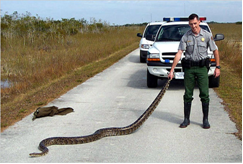 Wildlife officer with python.
Wildlife officer with python. Melaleuca covers thousands of acres.
Melaleuca covers thousands of acres.The 2010 Greater Everglades Ecosystem Restoration (GEER) Conference in Naples, July 12-16, is devoting day one, from 9:00-5:30, to a review of science and management of invasive species. The Everglades Cooperative Invasive Species Management Area (E-CISMA) – a formal stakeholder partnership – will present updates on operations in South Florida.
The annual Invasive Species Summit is designed to develop a shared understanding of the threat of invasive species to Florida's natural resources, economy and quality of life. It brings together people from the Greater Everglades area to discuss operations and issues to combat invasive species through a multi-agency annual work plan. Discussions acquaint participants with the various roles, activities and complexities required to combat invasives.
The intended audience for this session includes invasive species control experts, land managers, researchers, program managers and anyone with an interest in understanding what invasive species activities are occurring in the Everglades.
There is no fee to participate in the day-long Summit, but advanced registration is required through http://conference.ifas.ufl.edu/ GEER2010/index.htm, the GEER 2010 online registration. To attend the remainder of the GEER meeting, you must pay the applicable GEER registration fee. For more information contact Beth Miller-Tipton, GEER 2010 Coordinator, University of Florida bmt@ufl.edu.
[top]
Duval County Coast Guard Unit Paves the Way
For First Responders
While SART members network and train for all-hazard disaster preparedness, sister agencies are following similar routines, all with the primary goal of ensuring that we can, individually and collectively, respond effectively to a crisis. Some agencies have a pro-active, boots-on-the-ground mission.
We normally think of the U.S. Coast Guard saving boaters in emergencies and giving safety lectures, but under DHS their duties have expanded. Based at Naval Air Station Cecil Field in Duval County, a small but elite USCG unit called HITRON – Helicopter Interdiction Tactical Squadron – is continually available for smuggling interdiction. Flying weaponized MH-65C Dolphin helicopters from the deck of USCG Cutters in the Caribbean, the Pacific and elsewhere, HITRON crews intercept drug traffickers and stop them for boarding by armed inspection teams.
 A successful interdiction by US Coast Guard HITRON-Jacksonville means that millions of dollars of drugs - usually cocaine - does not enter the U.S.
A successful interdiction by US Coast Guard HITRON-Jacksonville means that millions of dollars of drugs - usually cocaine - does not enter the U.S.Of course, drug smugglers don’t want to stop and they employ aircraft, individuals (called “mules”), tunnels under the border and boats – even homemade submarines – to ship narcotics. One popular boat is called a “cigarette boat.” HITRON calls them “go-fasts.” These boats may carry 100 bales of raw, pure cocaine and can race across a moderate sea at speeds of nearly 100 mph. Depending upon how it is cut (“watered down” with impurities so the human body can absorb it) and where it is sold a shipment can be worth $250 million in the U.S.

Once a go-fast is detected, a Dolphin is scrambled. Racing toward the boat, the helicopter signals it to halt for inspection. A go-fast carrying drugs will attempt to evade, increase speed recklessly and sometimes dump the drugs into the ocean. If it stops, the helicopter hovers to provide cover for the armed USCG boarding party arriving on its own go-fast, launched from the Cutter. If it does not, the helo’s gunner fires warning bursts across the bow with a M240B 7.62x51mm machine gun. When the drug smuggler cuts to the side the helicopter also swerves and its gunner smashes the boat’s engines with.50 caliber copper bullets fired from a Barrett M107 rifle. If a smuggler should misjudge and fire back, the gunner is authorized to shoot-to-kill with an M14 7.62x51mm sniper rifle. And this from the open door of a speeding, swerving helicopter at a similarly speeding, bouncing swerving small boat – usually, at night!
The result, says HITRON gunner PO3 Kimberly Dechmarowski, the first female helicopter gunner in USCG history, is never to kill anyone, only to stop the boat and halt the flow of narcotics into the U.S.
HITRON – Force From Above. www.uscg.mil/LANTAREA/HITRON/. For a recent story about HITRON and the U.S. Coast Guard’s drug interdiction mission in Parade Magazine, visit www.parade.com/news/2010/01/27-stopping-drugs-at-sea.html.
[top]
Brevard Animal Control Worker is Attacked
On January 19th, a man attacked a Brevard County Animal Services employee in her home, stabbing her in the face and the abdomen. Based on the woman’s testimony, detectives have said it appears to be an act of revenge, perhaps because a dog was euthanized. The victim said her attacker also threatened others in Animal Services.
Brevard County Animal Services Director Mike McFarland noted that his division works in a business that must deal with heightened emotions and that these emotions can sometimes cause people to “act illogically.” Security has been added at the Titusville shelter.
McFarland, who has animal experience in Utah, California and now, Florida, says that both professional responders and even volunteers who work with animals that are regarded as pets must maintain “situational awareness.” The emotions of owners can run high at any time, especially when there is an environmental or a personal crisis.
He also suggests that animal control officers and individuals working at shelters be careful about releasing personal information such as their address and telephone number … or even their email address.
In part Excerpted from FACA Trax, 1st Quarter 2010 http://floridaanimalcontrol.org/
… and success as Brevard engages the public.

Because county animal services departments have a mission, even in – or perhaps especially in – difficult economic times, Michael McFarland and the folks from Brevard have maintained an aggressive posture to animal care and to the infrastructure needed.
“The keys are to engage the community,” McFarland says. “We’ve initiated that here in Brevard and we have volunteers and money for support coming in from the area. We’re part of organizational meetings to develop a 501(c)3 non-profit to support shelter operations and develop a more formal public-private partnership. It could be that the long-range future of parks and recreation in general is heading in that direction.”

McFarland notes that Brevard’s facilities have become old and dilapidated, but the mission of and demand for caring for animals has only grown. “Ours is a mission that energizes the public,” he says, “and we’ve been able – with lots of public support and lots of outreach effort – to decrease euthanasia, increase adoptions and build better care facilities at a time when government dollars are declining.”
The old Titusville facility, for example, was in “deplorable condition” and his agency closed it for rehabilitation, needing – they estimated - $5,000 for the work. But the people of the area responded with twice that much and a local professional carpenter volunteered to help them practically rebuild a significant part of the interior.
According to McFarland “when word about our need gets out to the public people respond. We got a $5,000 check for the re-hab from a lady in Orlando, for example.” McFarland nots that support from county management has been crucial and specifically thanked county manager Howard Tipton who has been on the job less than two years.
For information visit www.brevardanimalservices.com and note especially that Saturday, April 10 is the “Grand Re-Opening” of their North Animal Care Center at 2605 Flake Road, Titusville FL 32976. "This project is dedicated to the Brevard County Animal Services mission of placing more homeless pets into quality homes," McFarland writes.
[top]Worst Weed in the World
What's Cogon grass and why should I care?
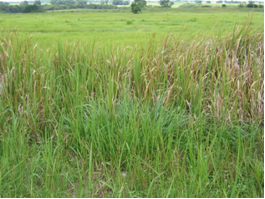
Incredibly, it has been more than 30 years since the movie Alien introduced us to aggressive, invasive creatures. So where is Sigourney Weaver when we need her?
Cogon grass is an invasive, non-native grass that affects pine productivity and survival, wildlife habitat, recreation, agricultural lands, native plants, fire behavior, site management costs and much more. FDACS says it is one of the "Top 10 Worst Weeds in the World,” and it’s loose in Florida.
It’s no small matter that an invasive, aggressive grass could be a “serious threat.” It’s spreading with “very efficient” airborne seeds and underground rhizomes (horizontal plant stems with shoots above and roots below serving as a reproductive structure). It often spreads on contaminated forestry and construction equipment and, once established, eradication may take 3-5 years of diligent and costly herbicide treatments.
If you have land infested with Cogon grass, FDACS says:
– It will spread and your situation will worsen
– It will decrease native plant biodiversity and wildlife habitat quality
– It will increase your fire hazard and associated damages
– It will impact your neighbors’ property
– It will make pine regeneration nearly impossible
– It will decrease your land management options
– The longer you delay treatment, the more expensive treatment will be
– It will lower the value of your real estate
– It is not palatable as livestock forage
Cogon grass is a state and federal noxious weed. It is illegal to sell hay or sod from cogon grass-infested fields. Human movement of the grass in any fashion is illegal.
See http://www.flof.com/forest_management/fh_invasives_cogon.html for more information. For treatment see http://plants.ifas.ufl.edu/parks/cogon_grass.html. For assistance visit http://floridainvasives.org or contact your local County Forester or Extension Agent.
[top]
All in the (responder) family
On February 5, Trooper Grace Luh of the Florida Highway Patrol was sworn-in at Troop F Headquarters in Bradenton. Trooper Luh began her career with FHP in 1988. After 11 years of service she entered the part time reserves so that she could concentrate on raising her family. After 10 years as a reserve trooper, she has returned to FHP duty full time. In this photo at the re-swearing-in ceremony, she poses with her husband Captain Lawrence Luh of the Manatee County EMS.
Photo courtesy FHP
Many families sacrifice to advance the agricultural (and animal) or responder cause. They are worthy of recognition and their stories can be inspirational and educational. Why not give us a "heads up" and your Sentinel will contact them for possible inclusion in a future newsletter:rsa5@cox.net.
Tale of Three Horses
So much of what we do in planning, training and response is serious that every now and then we ought to take a moment for our own sort of in-bred levity. Such is the case with the horses we work and train with, three of which are presented below.
Fugly | Rescue Randy | UF CVM |
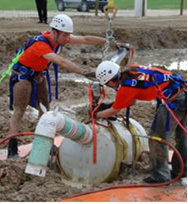 |
 |
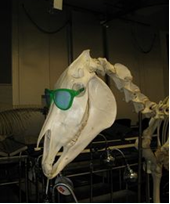 |
| This nag has obviously seen better days. | UF CVM's tough new kid has arrived in town. | And now to assist with your surgery…. |
[top]
About the SART Sentinel |
Editor: Rick Sapp, PhD, Technical Writer, Florida Department of Agriculture & Consumer Services, Division of Animal Industry [rsa5@cox.net] Associate Editor: Joe Kight, State ESF-17 Coordinator, Florida Department of Agriculture & Consumer Services, Division of Animal Industry [kightj@doacs.state.fl.us] The SART SENTINEL is an E-mail newsletter prepared monthly by Rick Sapp and the members of the Florida State Agricultural Response Team. Past issues of the Sentinel are archived on the Florida SART Web Site, www.flsart.org. If you have a story or photo that you would like to have considered for publication in The SART SENTINEL, please contact the Editors. [top] |
